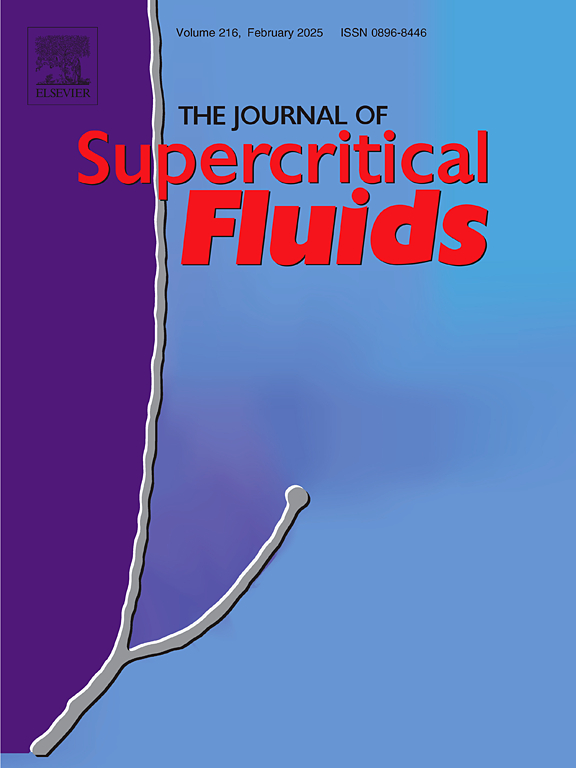Stability assessment of sulfided NiMo-based catalysts for continuous flow supercritical water hydrodeoxygenation applications
IF 4.4
3区 工程技术
Q2 CHEMISTRY, PHYSICAL
引用次数: 0
Abstract
Sulfided NiMo-based catalysts are widely used in hydroprocessing, including hydrotreating and hydrocracking in petroleum refining and renewable fuel production via biomass conversion. The development of hydrothermal liquefaction (HTL) for biocrude production has increased interest in direct hydrothermal upgrading processes, such as (hydro)deoxygenation and desulfurisation. This study evaluated the stability of NiMo- and NiW-based catalysts under continuous-flow conditions to assess their suitability for hydrothermal upgrading. After just 2 h in supercritical water (SCW), significant metal leaching was observed: Mo losses ranged from 47 % to 97 %, and Ni losses from 35 % to 80 %. Sulfidation provided only modest improvement, with losses still at 56–80 % for Mo and 52–75 % for Ni. Tungsten loss reached 90 % in the sulfided NiW catalyst. Mo leaching was particularly severe during the heating phase, with over 60 % of Mo and around 20 % of Ni lost during heating and cooling, peaking at 200 °C. At 400 °C, leaching rates from unreduced NiMo/AC were 0.4 mg h⁻¹ for Ni and 10 mg h⁻¹ for Mo. Sulfided NiMo showed better Mo stability, with leaching rates of 0.24 mg h⁻¹ for Ni and 3.6 mg h⁻¹ for Mo. These findings highlight the importance of assessing catalyst stability under realistic flow conditions. NiMo-, NiW-, and by extension, CoMo- and CoW-based catalysts are unsuitable for hydrothermal upgrading due to poor stability in SCW, particularly during heat-up and cool-down phases.
连续流超临界水加氢脱氧硫化镍基催化剂的稳定性评价
硫化镍基催化剂广泛应用于加氢加工,包括石油炼制中的加氢处理和加氢裂化,以及通过生物质转化生产可再生燃料。用于生物原油生产的水热液化(HTL)的发展增加了人们对水热直接升级工艺的兴趣,例如(氢)脱氧和脱硫。本研究评价了nio -和niw -催化剂在连续流动条件下的稳定性,以评价其在水热提质中的适用性。在超临界水(SCW)中仅2 h后,就观察到显著的金属浸出:Mo损失率从47 %到97 %,Ni损失率从35 %到80 %。硫化只提供了适度的改善,Mo的损失仍然在56-80 %,Ni的损失仍然在52-75 %。硫化NiW催化剂的钨损失率达到90% %。Mo浸出在加热阶段尤为严重,在加热和冷却期间Mo的损失超过60% %,Ni的损失约为20% %,在200°C时达到峰值。在400°C时,未还原的NiMo/AC的浸出率为0.4 mg h毒血症Ni和10 mg h毒血症Mo。硫化的NiMo表现出更好的Mo稳定性,Ni的浸出率为0.24 mg h毒血症h, Mo的浸出率为3.6 mg h毒血症h。这些发现强调了在实际流动条件下评估催化剂稳定性的重要性。NiMo-、NiW-以及CoMo-和cow -基催化剂不适合水热提质,因为它们在超临界水中的稳定性较差,尤其是在加热和冷却阶段。
本文章由计算机程序翻译,如有差异,请以英文原文为准。
求助全文
约1分钟内获得全文
求助全文
来源期刊

Journal of Supercritical Fluids
工程技术-工程:化工
CiteScore
7.60
自引率
10.30%
发文量
236
审稿时长
56 days
期刊介绍:
The Journal of Supercritical Fluids is an international journal devoted to the fundamental and applied aspects of supercritical fluids and processes. Its aim is to provide a focused platform for academic and industrial researchers to report their findings and to have ready access to the advances in this rapidly growing field. Its coverage is multidisciplinary and includes both basic and applied topics.
Thermodynamics and phase equilibria, reaction kinetics and rate processes, thermal and transport properties, and all topics related to processing such as separations (extraction, fractionation, purification, chromatography) nucleation and impregnation are within the scope. Accounts of specific engineering applications such as those encountered in food, fuel, natural products, minerals, pharmaceuticals and polymer industries are included. Topics related to high pressure equipment design, analytical techniques, sensors, and process control methodologies are also within the scope of the journal.
 求助内容:
求助内容: 应助结果提醒方式:
应助结果提醒方式:


